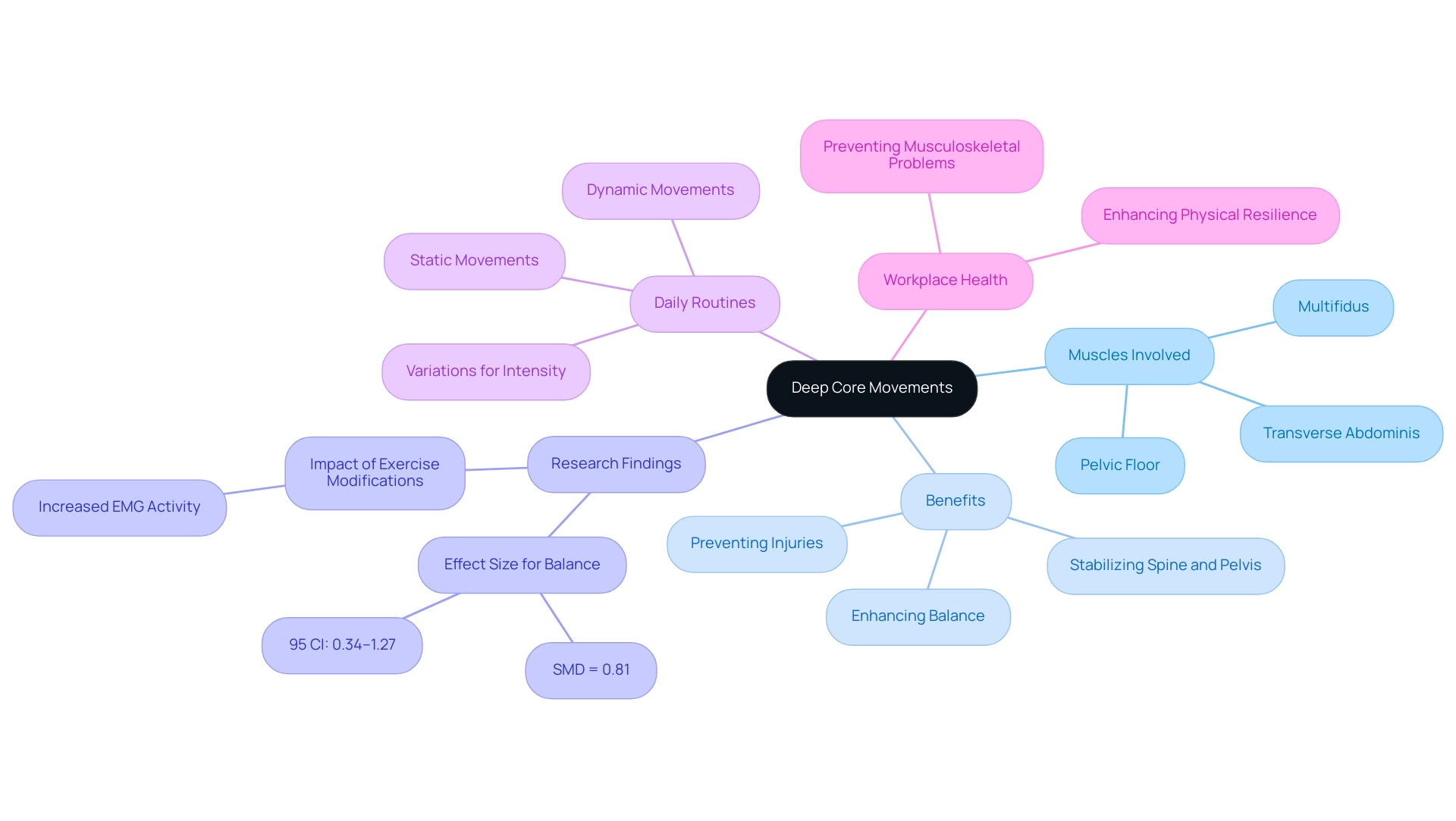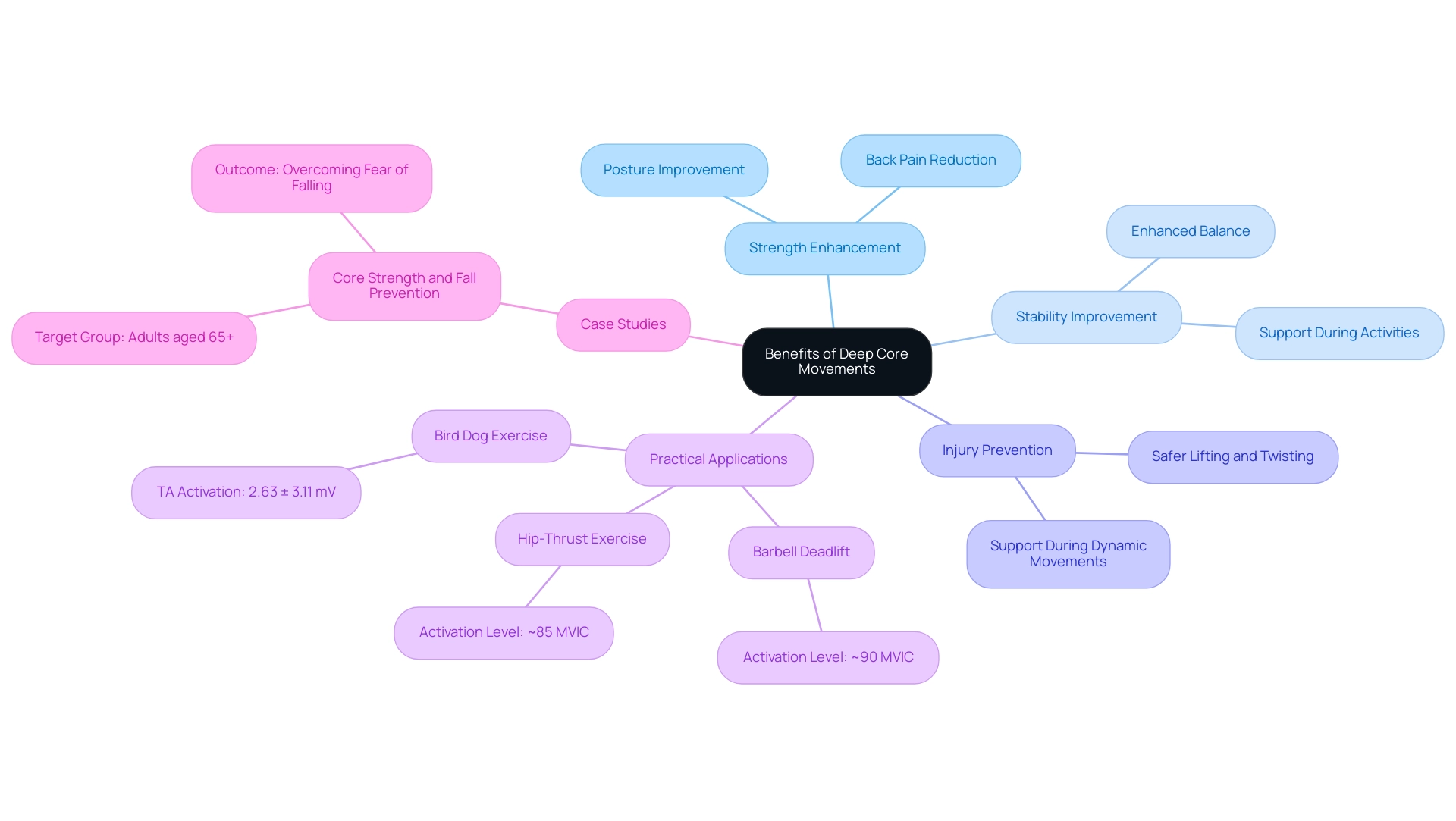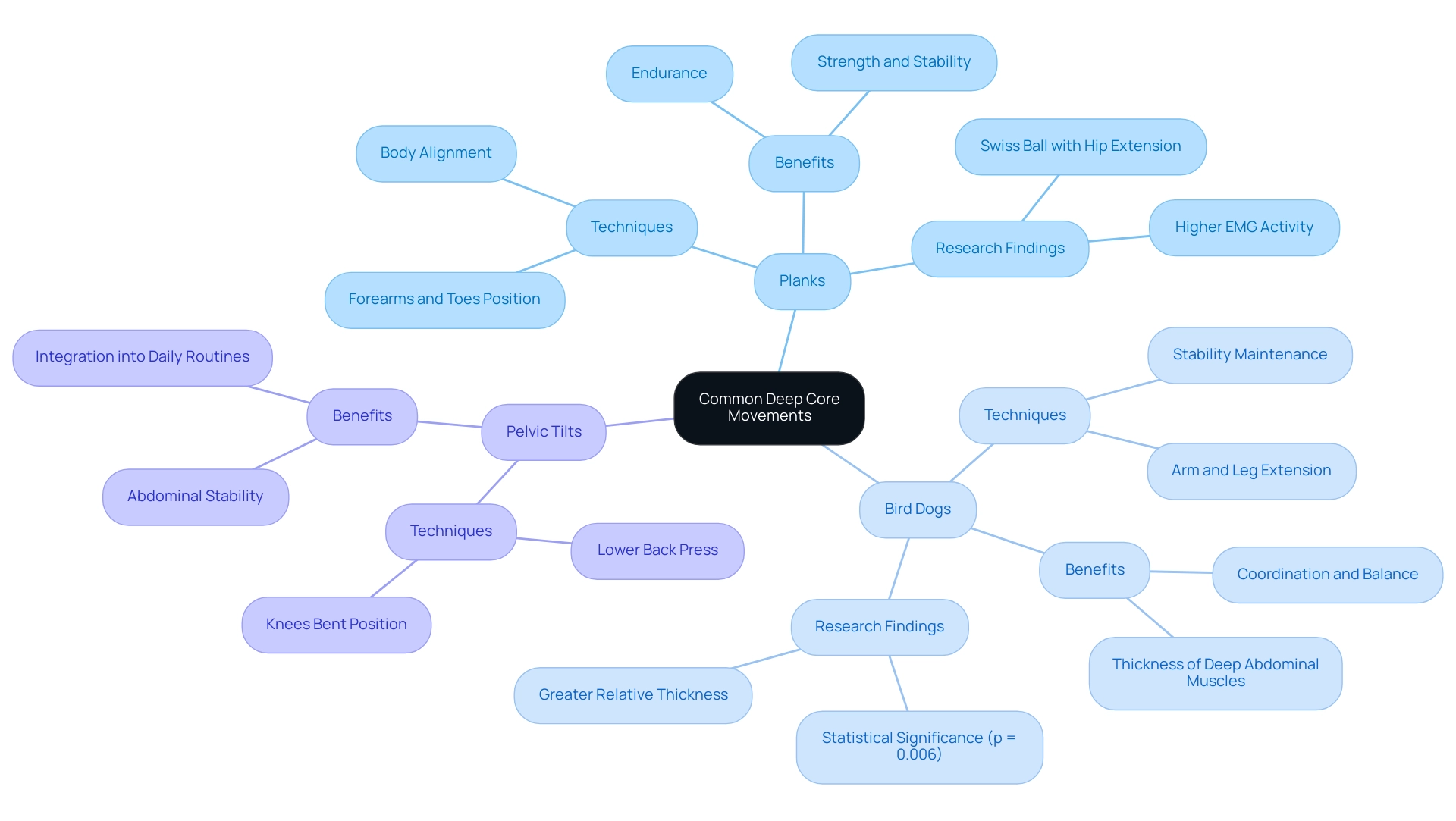Overview
Deep core movements are essential exercises that engage deeper abdominal muscles, providing stability and strength crucial for everyday activities and injury prevention. The article supports this by detailing how these movements, such as planks and bird dogs, enhance muscle activation and overall physical resilience, thereby improving posture, balance, and reducing back pain, which are vital for maintaining health in both personal and workplace settings.
Introduction
In the quest for a healthier workforce, deep core movements emerge as a game-changer, offering a powerful foundation for both physical and mental well-being. These essential exercises engage the deeper layers of core musculature, providing vital support for the spine and pelvis while enhancing stability and strength.
As organizations increasingly recognize the importance of employee wellness, integrating deep core movements into daily routines and workplace programs not only fosters resilience but also cultivates a culture of health that can lead to improved productivity and reduced absenteeism.
By prioritizing these movements, HR Benefits Managers can empower their teams to thrive, transforming the workplace into a hub of vitality and engagement. Embracing the potential of deep core training is not just a trend—it's a commitment to nurturing a robust and dynamic workforce ready to tackle the challenges of modern work life.
Defining Deep Core Movements: What They Are and Why They Matter
Deep core movements are crucial routines that engage the deeper layers of abdominal musculature, including the transverse abdominis, pelvic floor, and multifidus. These exercises serve as the backbone for stabilizing the spine and pelvis, creating a robust foundation for all physical activities. Unlike conventional central workouts that frequently target superficial muscles, deep core movements emphasize functional strength and stability, which are essential for preserving proper posture and avoiding injuries.
Recent research highlights the significant impact of these actions on balance, evidenced by a standardized mean difference (SMD) of 0.81; 95% CI: 0.34–1.27, indicating considerable effectiveness in enhancing stability. This is particularly important in workplace settings where prolonged sitting can lead to musculoskeletal problems. As Wendi Weimar, PhD and director of the Sport Biomechanics Laboratory at Auburn University, states:
When you swing a tennis racket, kick a soccer ball, or pick up a crying toddler, the central muscles should activate before your limbs get to work.
By combining both dynamic and static fundamental exercises, along with variations for intensity and complexity into daily routines, individuals not only enhance their physical resilience but also protect their overall health. A study titled 'Impact of Activity Modifications on EMG Activity' found that adjustments, such as adding instability, significantly increased EMG activity in central muscles, showcasing how tailored routines can enhance muscle engagement during stability training. This approach paves the way for a more productive and injury-free work environment.

The Benefits of Deep Core Movements: Enhancing Strength and Stability
The benefits of deep core movements go beyond simple aesthetics; they are essential for improving overall strength and stability, which are important in both everyday activities and sports performance. Participating in activities focusing on the inner abdominal muscles can greatly enhance posture, reduce back pain, and improve balance. Research indicates that the transverse abdominis (TA) activation during the bird dog exercise reached an impressive 2.63 ± 3.11 mV, showcasing the effectiveness of targeted abdominal training.
Furthermore, strong deep core movements play a pivotal role in injury prevention by providing necessary support during dynamic activities such as lifting, twisting, and bending. This conditioning not only makes these movements safer but also more efficient. Furthermore, as emphasized by Kuan Dong from the Graduate School of Physical Education at Myongji University, "these results indicate that it is essential to properly design foundational training programs to enhance sport-specific athletic performance."
In terms of practical application, exercises like the barbell deadlift, which achieves approximately 90% MVIC, and the hip-thrust exercise, around 85% MVIC, demonstrate the high activation levels attainable through effective workouts for lower abdominal muscles. Furthermore, a research on essential strength and fall prevention for seniors shows that intensive abdominal training enhances functional fitness, enabling individuals to handle daily activities with ease and assurance. By supporting these initiatives, organizations can foster a culture of health that not only improves employee well-being but also boosts productivity and team performance.
Focusing on intensive foundational training can result in a more resilient workforce, prepared to tackle the challenges of both work and life, despite the current absence of thorough research on TA activation and the uniformity of measuring EMG activity across studies.

Common Deep Core Movements: Examples and Techniques
Key deep core movements such as planks, bird dogs, and pelvic tilts serve as fundamental activities for enhancing strength and stability. The plank, a powerhouse in central workouts, activates multiple muscle groups, promoting endurance and stability. To carry out this activity effectively, position your body face down, resting on your forearms and toes, ensuring a straight line from head to heels.
Engage your abdomen and maintain this alignment, avoiding any sagging or arching of your back. Research highlights that the front plank on a Swiss ball with hip extension showcases superior activation of the multifidus, indicating its effectiveness over static planks on the floor.
The bird dog activity further enhances coordination and balance, making it an essential addition to any routine. Begin on all fours, extending one arm forward while simultaneously stretching the opposite leg back. Maintain the position for several seconds before changing sides, ensuring stability throughout.
Notably, the Bonferroni post hoc test demonstrated that the bird dog activity had a statistically significant greater relative thickness compared to the plank (p = 0.006) and toe tap movements (p = 0.005). This exercise has been demonstrated to effectively enhance the thickness of deep abdominal muscles through specific activation maneuvers, as noted by Ioannis Tsartsapakis:
"These exercises have been shown to effectively increase the thickness of deep abdominal muscles through activation maneuvers."
Additionally, pelvic tilts can enhance abdominal stability. Lying on your back with your knees bent, gently press your lower back against the floor by activating your abdominal muscles. This simple yet effective movement can be seamlessly integrated into daily routines.
Incorporating deep core movements into regular fitness programs not only enhances strength but also sets a powerful example of wellness that HR Benefits Managers can champion within their teams. As shown in a study by Cugliari & Boccia (2017), suspended plank variations triggered substantial muscle activation, highlighting the effectiveness of innovative methods for conditioning the midsection. Embrace these actions to foster a healthier, more active workplace culture.

Integrating Deep Core Movements into Your Daily Routine
Incorporating deep core movements into your daily routine can be straightforward and highly effective, especially when backed by a corporate partnership with Foresight Health Coaching. Setting aside only 10 to 15 minutes daily for fundamental workouts is sufficient to create a notable impact, whether at home or in the workplace. For instance, you can engage in a series of planks during a short break or incorporate bird dogs while watching your favorite show.
Significantly, the bird dog movement has demonstrated a transversus abdominis (TA) activation of 2.63 ± 3.11 mV, emphasizing its effectiveness in enhancing abdominal muscles. Using standing desks not only encourages activity throughout the day but also offers a chance to perform pelvic tilts discreetly while you work. Encouraging team members to join in these short wellness breaks, which can be further enhanced through our partnership, fosters a supportive atmosphere and reinforces the importance of collective health.
According to the case study titled 'Conclusions on Core Muscle EMG Activity,' free-weight activities generated the highest engagement in abdominal muscles, while traditional movements were most effective for lumbar multifidus. By incorporating deep core movements into your daily routine and utilizing the resources available through Foresight Health Coaching, you improve your own well-being while setting an inspiring example for your colleagues. This collaborative effort cultivates a culture of wellness within your organization.
As wellness experts often highlight, these small adjustments can lead to profound improvements in overall health and productivity. J.M.O.-L. stresses that incorporating fundamental activities into daily routines necessitates conceptualization and validation, which can be greatly aided by our corporate partnership. Contact us now to explore how our corporate partnership can enhance your team's wellness initiatives and provide additional resources to support your efforts.

The Role of Deep Core Movements in Workplace Wellness Programs
Incorporating fundamental movements into workplace wellness initiatives offers an enticing chance for organizations to improve employee health and increase overall productivity. These exercises not only strengthen physical fitness but are also pivotal in promoting mental well-being. Regular physical activity, particularly intensive foundational training, has been demonstrated to significantly lower stress and anxiety levels, promoting a healthier workplace environment.
As 18% of employees characterize their workplace as harmful, introducing wellness initiatives centered on fundamental exercises becomes increasingly essential. By arranging workshops or fitness classes focused on these activities, organizations can actively promote their teams to prioritize their health. Additionally, offering resources such as instructional videos or engaging fitness challenges can cultivate a culture of participation and motivation among employees.
According to Wellable, ninety-four percent of brokers indicate that many or all of their employer clients invest in rewards and incentives to enhance their wellness programs, highlighting the growing recognition of their significance. Furthermore, the Gallup Net Thriving Assessment underscores the necessity of tracking employee well-being metrics to predict workforce resiliency. By embedding deep core movements into their wellness initiatives, organizations can not only demonstrate their commitment to employee health but also expect tangible outcomes, such as increased job satisfaction, reduced absenteeism, and enhanced productivity.
This proactive approach to healthcare costs can lead to significant savings on insurance premiums in the long run. This commitment can truly transform the workplace, creating a thriving environment for everyone involved.

Conclusion
Integrating deep core movements into workplace wellness programs is not merely a beneficial addition; it is a transformative strategy that can reshape the health landscape of an organization. These exercises engage essential core muscles, enhancing both physical stability and mental well-being, which are crucial for a thriving work environment. By focusing on deep core movements, employees can experience improved posture, reduced back pain, and enhanced balance, all of which contribute to greater productivity and fewer injuries.
Moreover, the simplicity of incorporating these movements into daily routines cannot be overstated. Just 10 to 15 minutes of dedicated core exercises can lead to significant improvements in overall health. Encouraging team participation in wellness breaks not only fosters a supportive culture but also reinforces the importance of collective health and resilience. As organizations embrace these practices, they signal a commitment to nurturing their workforce, ultimately leading to heightened job satisfaction and lower absenteeism.
The evidence is clear: prioritizing deep core training is an investment in the well-being of employees. By actively promoting and integrating these movements into wellness initiatives, HR Benefits Managers can cultivate a robust, engaged, and dynamic workforce. This commitment not only enhances individual health but also contributes to a thriving organizational culture, paving the way for success in today's fast-paced work environment. Now is the time to take action and champion the integration of deep core movements—transforming the workplace into a hub of vitality and engagement.




